ACCM 4400 Auditing & Assurance: Financial Analysis & Audit Quality
VerifiedAdded on 2023/04/22
|14
|2795
|367
Report
AI Summary
This audit report is divided into two parts. Part A focuses on the financial statement analysis of AMP Ltd, identifying key areas of concern from an audit perspective, including profitability, liquidity, solvency, valuation of life insurance contract liabilities, and investment valuation. It also suggests relevant audit procedures to assess and minimize business risks. Part B delves into the concept of audit quality, discussing the IAASB framework comprising input, process, and output factors. It highlights steps taken by accounting bodies like PCAOB, IAASB, and CAANZ to maintain audit quality and emphasizes the importance of high-quality audits in supporting financial stability, reducing fraud, and promoting effective control. The report concludes by underscoring the primary role of an audit in ensuring financial statements are free from material misstatements and providing confidence to stakeholders.
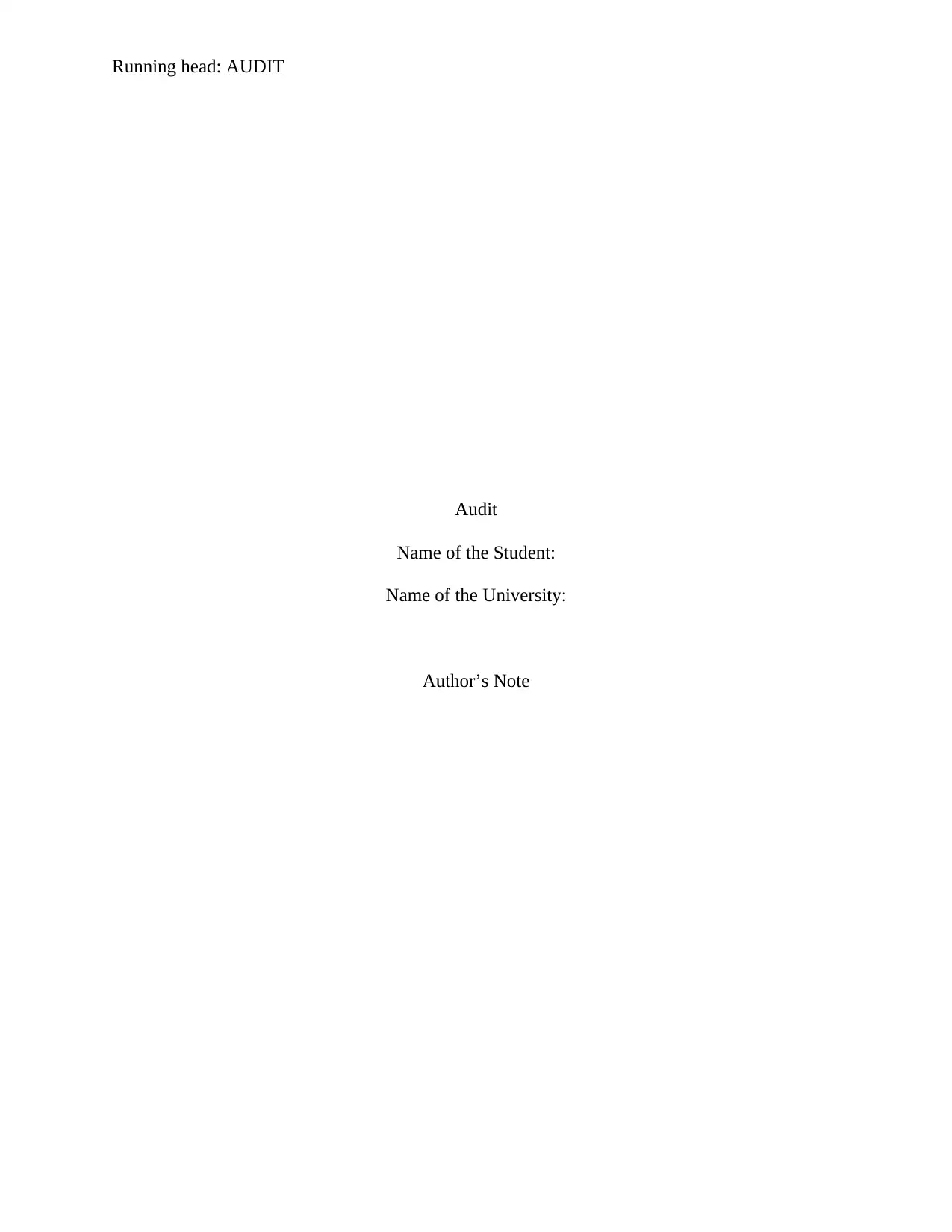
Running head: AUDIT
Audit
Name of the Student:
Name of the University:
Author’s Note
Audit
Name of the Student:
Name of the University:
Author’s Note
Paraphrase This Document
Need a fresh take? Get an instant paraphrase of this document with our AI Paraphraser
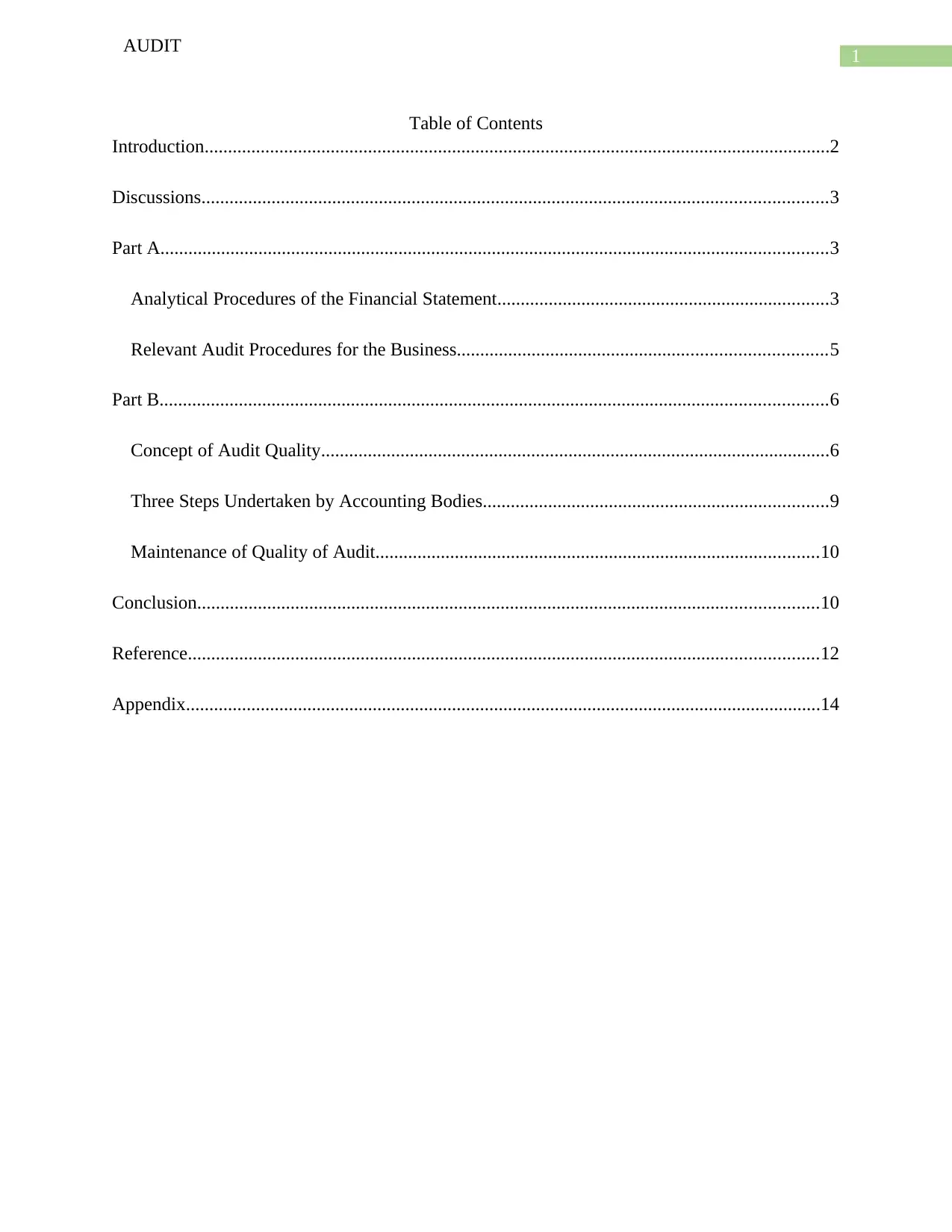
1
AUDIT
Table of Contents
Introduction......................................................................................................................................2
Discussions......................................................................................................................................3
Part A...............................................................................................................................................3
Analytical Procedures of the Financial Statement.......................................................................3
Relevant Audit Procedures for the Business...............................................................................5
Part B...............................................................................................................................................6
Concept of Audit Quality.............................................................................................................6
Three Steps Undertaken by Accounting Bodies..........................................................................9
Maintenance of Quality of Audit...............................................................................................10
Conclusion.....................................................................................................................................10
Reference.......................................................................................................................................12
Appendix........................................................................................................................................14
AUDIT
Table of Contents
Introduction......................................................................................................................................2
Discussions......................................................................................................................................3
Part A...............................................................................................................................................3
Analytical Procedures of the Financial Statement.......................................................................3
Relevant Audit Procedures for the Business...............................................................................5
Part B...............................................................................................................................................6
Concept of Audit Quality.............................................................................................................6
Three Steps Undertaken by Accounting Bodies..........................................................................9
Maintenance of Quality of Audit...............................................................................................10
Conclusion.....................................................................................................................................10
Reference.......................................................................................................................................12
Appendix........................................................................................................................................14
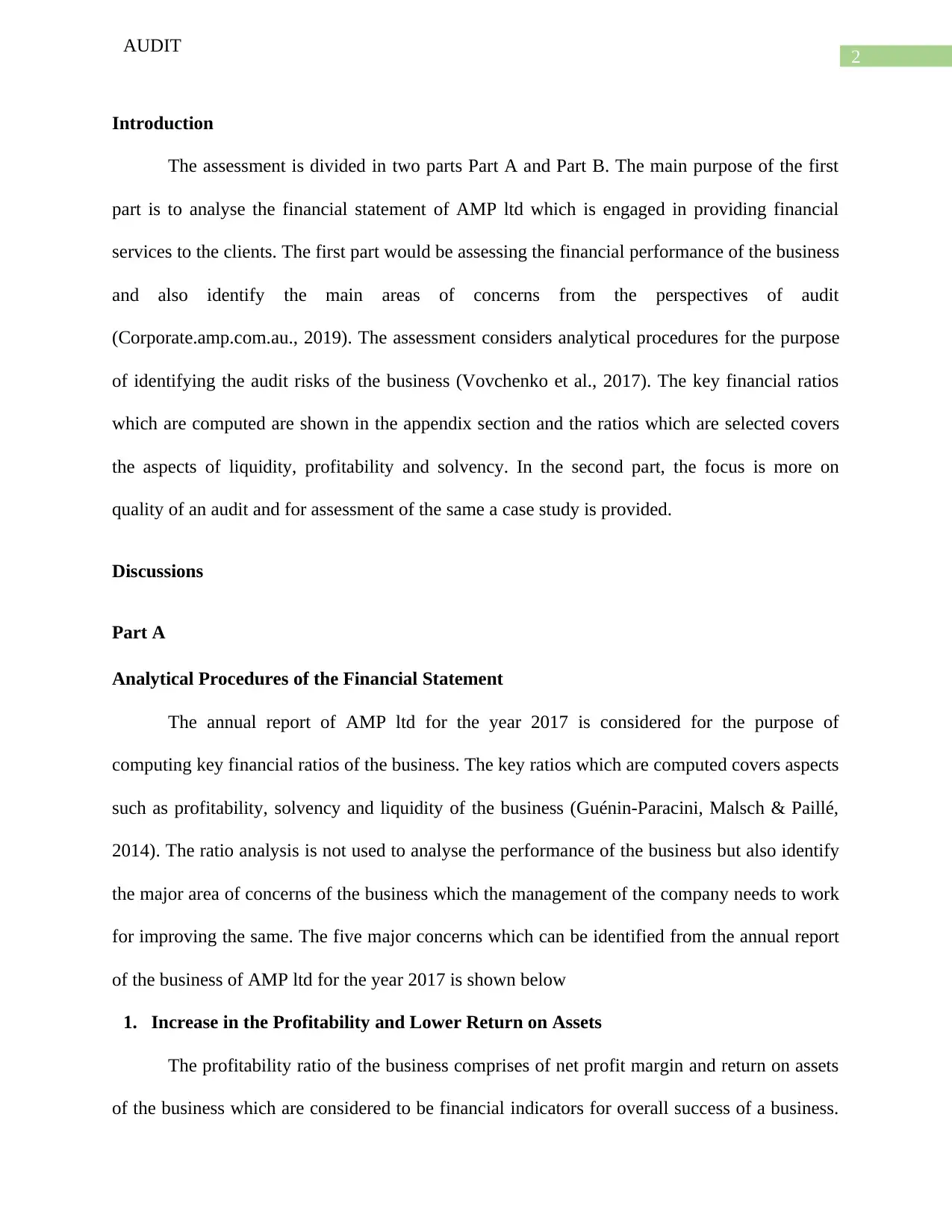
2
AUDIT
Introduction
The assessment is divided in two parts Part A and Part B. The main purpose of the first
part is to analyse the financial statement of AMP ltd which is engaged in providing financial
services to the clients. The first part would be assessing the financial performance of the business
and also identify the main areas of concerns from the perspectives of audit
(Corporate.amp.com.au., 2019). The assessment considers analytical procedures for the purpose
of identifying the audit risks of the business (Vovchenko et al., 2017). The key financial ratios
which are computed are shown in the appendix section and the ratios which are selected covers
the aspects of liquidity, profitability and solvency. In the second part, the focus is more on
quality of an audit and for assessment of the same a case study is provided.
Discussions
Part A
Analytical Procedures of the Financial Statement
The annual report of AMP ltd for the year 2017 is considered for the purpose of
computing key financial ratios of the business. The key ratios which are computed covers aspects
such as profitability, solvency and liquidity of the business (Guénin-Paracini, Malsch & Paillé,
2014). The ratio analysis is not used to analyse the performance of the business but also identify
the major area of concerns of the business which the management of the company needs to work
for improving the same. The five major concerns which can be identified from the annual report
of the business of AMP ltd for the year 2017 is shown below
1. Increase in the Profitability and Lower Return on Assets
The profitability ratio of the business comprises of net profit margin and return on assets
of the business which are considered to be financial indicators for overall success of a business.
AUDIT
Introduction
The assessment is divided in two parts Part A and Part B. The main purpose of the first
part is to analyse the financial statement of AMP ltd which is engaged in providing financial
services to the clients. The first part would be assessing the financial performance of the business
and also identify the main areas of concerns from the perspectives of audit
(Corporate.amp.com.au., 2019). The assessment considers analytical procedures for the purpose
of identifying the audit risks of the business (Vovchenko et al., 2017). The key financial ratios
which are computed are shown in the appendix section and the ratios which are selected covers
the aspects of liquidity, profitability and solvency. In the second part, the focus is more on
quality of an audit and for assessment of the same a case study is provided.
Discussions
Part A
Analytical Procedures of the Financial Statement
The annual report of AMP ltd for the year 2017 is considered for the purpose of
computing key financial ratios of the business. The key ratios which are computed covers aspects
such as profitability, solvency and liquidity of the business (Guénin-Paracini, Malsch & Paillé,
2014). The ratio analysis is not used to analyse the performance of the business but also identify
the major area of concerns of the business which the management of the company needs to work
for improving the same. The five major concerns which can be identified from the annual report
of the business of AMP ltd for the year 2017 is shown below
1. Increase in the Profitability and Lower Return on Assets
The profitability ratio of the business comprises of net profit margin and return on assets
of the business which are considered to be financial indicators for overall success of a business.
⊘ This is a preview!⊘
Do you want full access?
Subscribe today to unlock all pages.

Trusted by 1+ million students worldwide
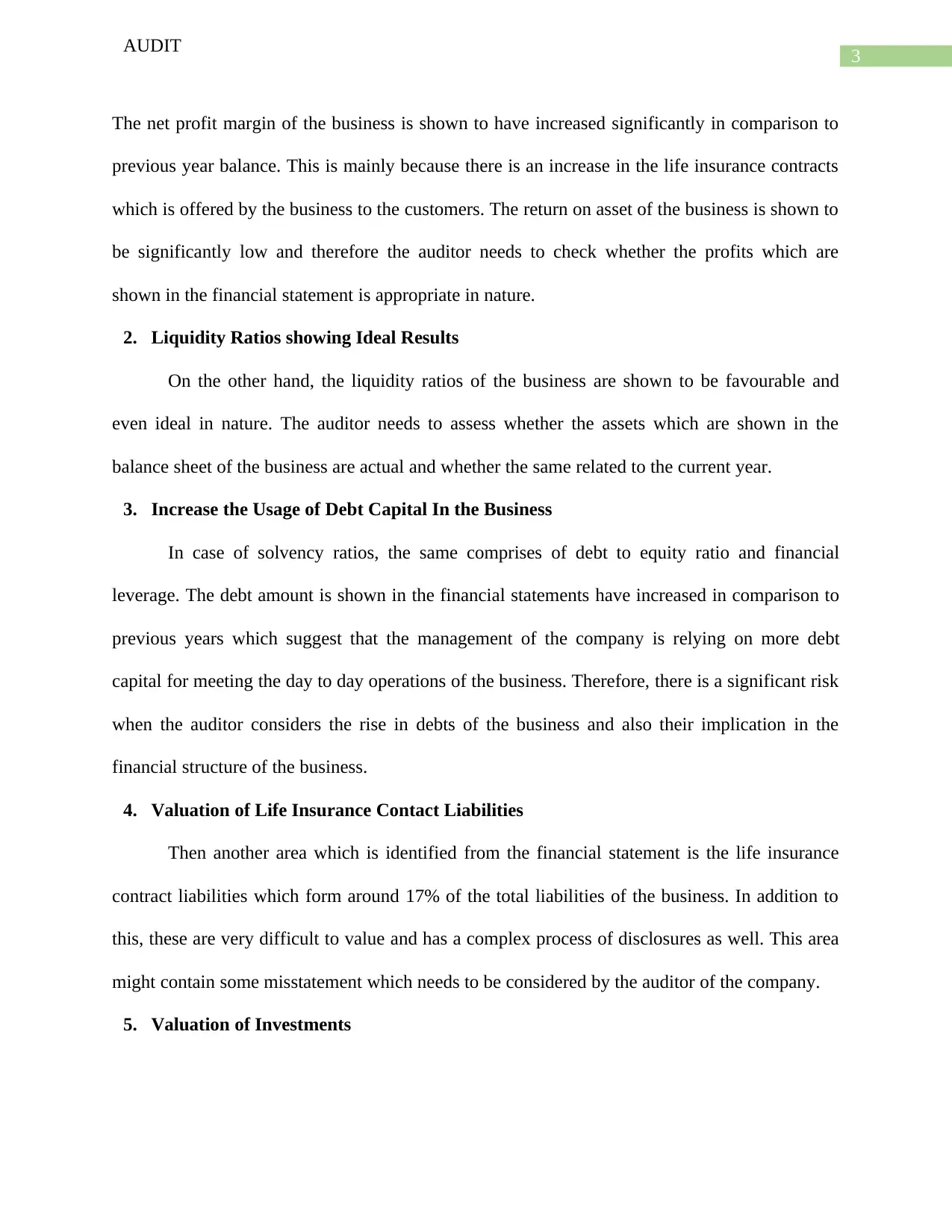
3
AUDIT
The net profit margin of the business is shown to have increased significantly in comparison to
previous year balance. This is mainly because there is an increase in the life insurance contracts
which is offered by the business to the customers. The return on asset of the business is shown to
be significantly low and therefore the auditor needs to check whether the profits which are
shown in the financial statement is appropriate in nature.
2. Liquidity Ratios showing Ideal Results
On the other hand, the liquidity ratios of the business are shown to be favourable and
even ideal in nature. The auditor needs to assess whether the assets which are shown in the
balance sheet of the business are actual and whether the same related to the current year.
3. Increase the Usage of Debt Capital In the Business
In case of solvency ratios, the same comprises of debt to equity ratio and financial
leverage. The debt amount is shown in the financial statements have increased in comparison to
previous years which suggest that the management of the company is relying on more debt
capital for meeting the day to day operations of the business. Therefore, there is a significant risk
when the auditor considers the rise in debts of the business and also their implication in the
financial structure of the business.
4. Valuation of Life Insurance Contact Liabilities
Then another area which is identified from the financial statement is the life insurance
contract liabilities which form around 17% of the total liabilities of the business. In addition to
this, these are very difficult to value and has a complex process of disclosures as well. This area
might contain some misstatement which needs to be considered by the auditor of the company.
5. Valuation of Investments
AUDIT
The net profit margin of the business is shown to have increased significantly in comparison to
previous year balance. This is mainly because there is an increase in the life insurance contracts
which is offered by the business to the customers. The return on asset of the business is shown to
be significantly low and therefore the auditor needs to check whether the profits which are
shown in the financial statement is appropriate in nature.
2. Liquidity Ratios showing Ideal Results
On the other hand, the liquidity ratios of the business are shown to be favourable and
even ideal in nature. The auditor needs to assess whether the assets which are shown in the
balance sheet of the business are actual and whether the same related to the current year.
3. Increase the Usage of Debt Capital In the Business
In case of solvency ratios, the same comprises of debt to equity ratio and financial
leverage. The debt amount is shown in the financial statements have increased in comparison to
previous years which suggest that the management of the company is relying on more debt
capital for meeting the day to day operations of the business. Therefore, there is a significant risk
when the auditor considers the rise in debts of the business and also their implication in the
financial structure of the business.
4. Valuation of Life Insurance Contact Liabilities
Then another area which is identified from the financial statement is the life insurance
contract liabilities which form around 17% of the total liabilities of the business. In addition to
this, these are very difficult to value and has a complex process of disclosures as well. This area
might contain some misstatement which needs to be considered by the auditor of the company.
5. Valuation of Investments
Paraphrase This Document
Need a fresh take? Get an instant paraphrase of this document with our AI Paraphraser
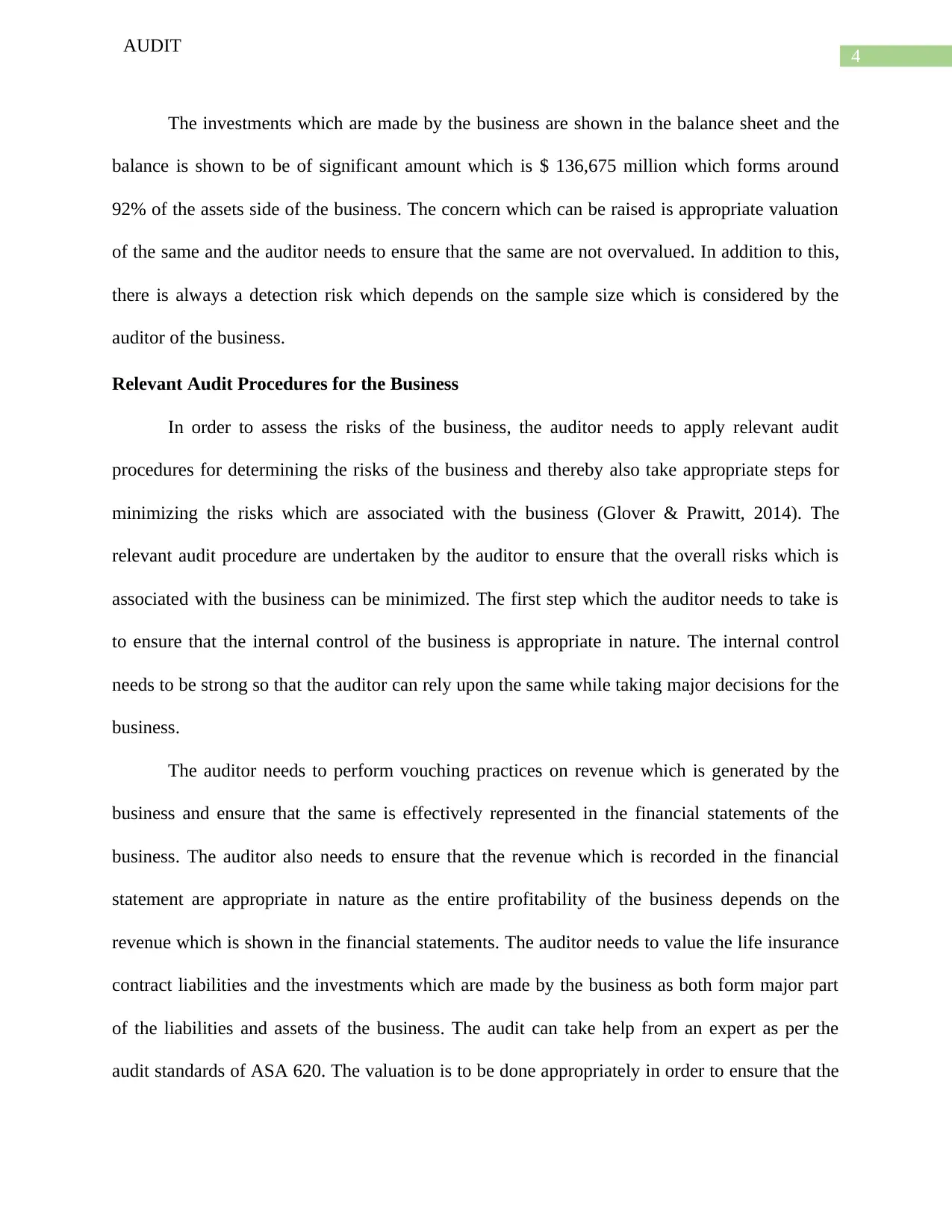
4
AUDIT
The investments which are made by the business are shown in the balance sheet and the
balance is shown to be of significant amount which is $ 136,675 million which forms around
92% of the assets side of the business. The concern which can be raised is appropriate valuation
of the same and the auditor needs to ensure that the same are not overvalued. In addition to this,
there is always a detection risk which depends on the sample size which is considered by the
auditor of the business.
Relevant Audit Procedures for the Business
In order to assess the risks of the business, the auditor needs to apply relevant audit
procedures for determining the risks of the business and thereby also take appropriate steps for
minimizing the risks which are associated with the business (Glover & Prawitt, 2014). The
relevant audit procedure are undertaken by the auditor to ensure that the overall risks which is
associated with the business can be minimized. The first step which the auditor needs to take is
to ensure that the internal control of the business is appropriate in nature. The internal control
needs to be strong so that the auditor can rely upon the same while taking major decisions for the
business.
The auditor needs to perform vouching practices on revenue which is generated by the
business and ensure that the same is effectively represented in the financial statements of the
business. The auditor also needs to ensure that the revenue which is recorded in the financial
statement are appropriate in nature as the entire profitability of the business depends on the
revenue which is shown in the financial statements. The auditor needs to value the life insurance
contract liabilities and the investments which are made by the business as both form major part
of the liabilities and assets of the business. The audit can take help from an expert as per the
audit standards of ASA 620. The valuation is to be done appropriately in order to ensure that the
AUDIT
The investments which are made by the business are shown in the balance sheet and the
balance is shown to be of significant amount which is $ 136,675 million which forms around
92% of the assets side of the business. The concern which can be raised is appropriate valuation
of the same and the auditor needs to ensure that the same are not overvalued. In addition to this,
there is always a detection risk which depends on the sample size which is considered by the
auditor of the business.
Relevant Audit Procedures for the Business
In order to assess the risks of the business, the auditor needs to apply relevant audit
procedures for determining the risks of the business and thereby also take appropriate steps for
minimizing the risks which are associated with the business (Glover & Prawitt, 2014). The
relevant audit procedure are undertaken by the auditor to ensure that the overall risks which is
associated with the business can be minimized. The first step which the auditor needs to take is
to ensure that the internal control of the business is appropriate in nature. The internal control
needs to be strong so that the auditor can rely upon the same while taking major decisions for the
business.
The auditor needs to perform vouching practices on revenue which is generated by the
business and ensure that the same is effectively represented in the financial statements of the
business. The auditor also needs to ensure that the revenue which is recorded in the financial
statement are appropriate in nature as the entire profitability of the business depends on the
revenue which is shown in the financial statements. The auditor needs to value the life insurance
contract liabilities and the investments which are made by the business as both form major part
of the liabilities and assets of the business. The audit can take help from an expert as per the
audit standards of ASA 620. The valuation is to be done appropriately in order to ensure that the
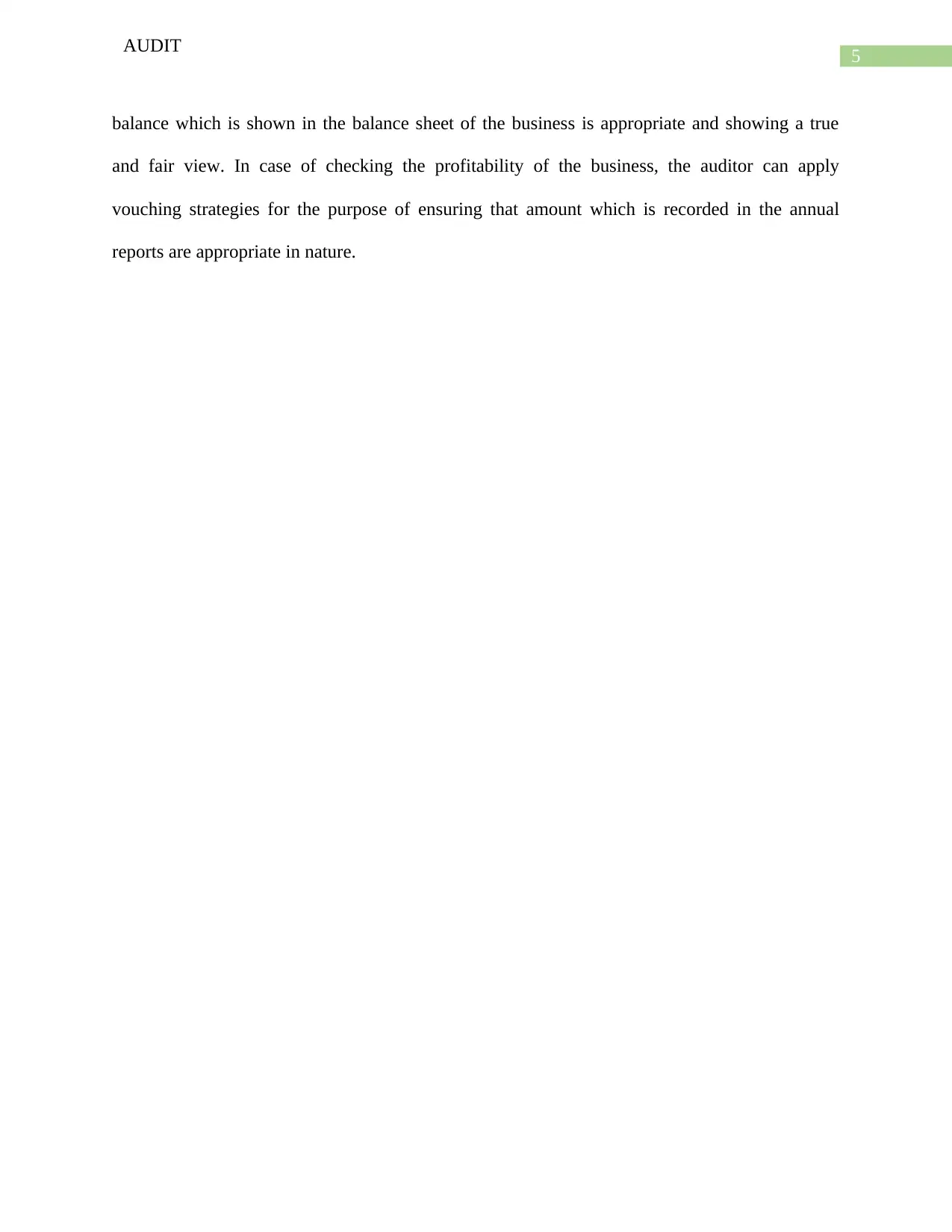
5
AUDIT
balance which is shown in the balance sheet of the business is appropriate and showing a true
and fair view. In case of checking the profitability of the business, the auditor can apply
vouching strategies for the purpose of ensuring that amount which is recorded in the annual
reports are appropriate in nature.
AUDIT
balance which is shown in the balance sheet of the business is appropriate and showing a true
and fair view. In case of checking the profitability of the business, the auditor can apply
vouching strategies for the purpose of ensuring that amount which is recorded in the annual
reports are appropriate in nature.
⊘ This is a preview!⊘
Do you want full access?
Subscribe today to unlock all pages.

Trusted by 1+ million students worldwide

6
AUDIT
Part B
Concept of Audit Quality
The concept of audit quality is widely used among the shareholders and other users of the
financial statements. As per the International Auditing and Assurance Standards Board (IAASB),
the definition of audit quality is complex and therefore cannot be defined (Gul, Wu & Yang,
2013). However, it is to be remembered that a professional should always take all the necessary
steps in order to ensure that the quality of audit is at all times maintained by the management of
the business. IAASB has introduced a framework whereby the audit quality is described by the
input, process and output factors that contribute to the overall audit quality.
The main function of an audit is to enhance the degree of confidence of the potential
users in the financial statements and the same is achieved by auditors by gathering sufficient
appropriate audit evidence in order to express an opinion on whether the financial statements are
showing true and fair view (Arruñada, 2013). It is to be noted that the responsibility for
performing audits with high quality rests primarily with auditors and the level of efficiency
which the auditor has. However, it is often noticed that audit quality can be best achieved in an
environment where there is support from, and appropriate interactions among, participants in the
financial reporting supply chain. This is the main concept and its states that both the auditor and
the management of the company needs to work together in order to ensure that high quality of
audit is conducted. This is not only beneficial for the business but also for the users of the
financial statements as the same can help effectively in decision-making process of the business.
AUDIT
Part B
Concept of Audit Quality
The concept of audit quality is widely used among the shareholders and other users of the
financial statements. As per the International Auditing and Assurance Standards Board (IAASB),
the definition of audit quality is complex and therefore cannot be defined (Gul, Wu & Yang,
2013). However, it is to be remembered that a professional should always take all the necessary
steps in order to ensure that the quality of audit is at all times maintained by the management of
the business. IAASB has introduced a framework whereby the audit quality is described by the
input, process and output factors that contribute to the overall audit quality.
The main function of an audit is to enhance the degree of confidence of the potential
users in the financial statements and the same is achieved by auditors by gathering sufficient
appropriate audit evidence in order to express an opinion on whether the financial statements are
showing true and fair view (Arruñada, 2013). It is to be noted that the responsibility for
performing audits with high quality rests primarily with auditors and the level of efficiency
which the auditor has. However, it is often noticed that audit quality can be best achieved in an
environment where there is support from, and appropriate interactions among, participants in the
financial reporting supply chain. This is the main concept and its states that both the auditor and
the management of the company needs to work together in order to ensure that high quality of
audit is conducted. This is not only beneficial for the business but also for the users of the
financial statements as the same can help effectively in decision-making process of the business.
Paraphrase This Document
Need a fresh take? Get an instant paraphrase of this document with our AI Paraphraser
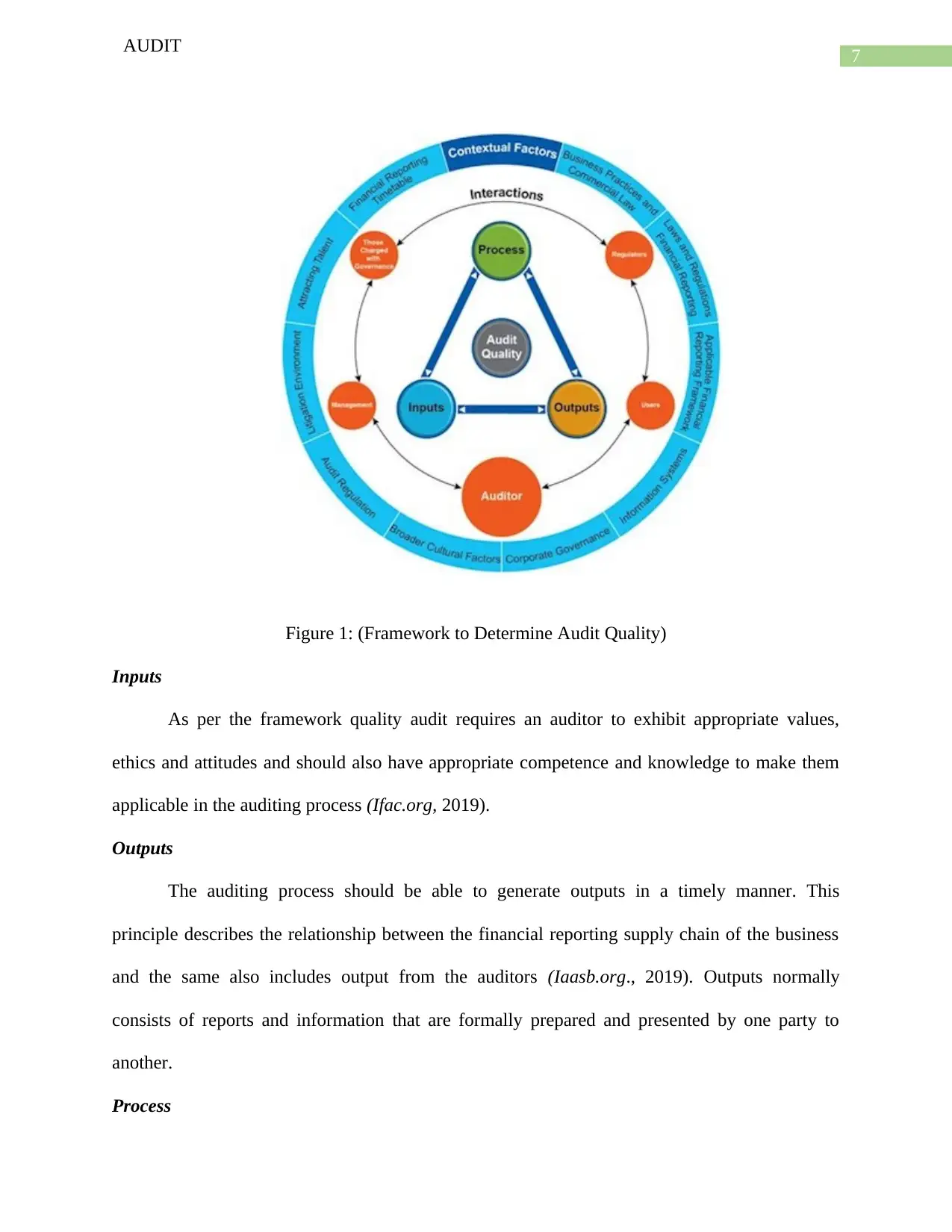
7
AUDIT
Figure 1: (Framework to Determine Audit Quality)
Inputs
As per the framework quality audit requires an auditor to exhibit appropriate values,
ethics and attitudes and should also have appropriate competence and knowledge to make them
applicable in the auditing process (Ifac.org, 2019).
Outputs
The auditing process should be able to generate outputs in a timely manner. This
principle describes the relationship between the financial reporting supply chain of the business
and the same also includes output from the auditors (Iaasb.org., 2019). Outputs normally
consists of reports and information that are formally prepared and presented by one party to
another.
Process
AUDIT
Figure 1: (Framework to Determine Audit Quality)
Inputs
As per the framework quality audit requires an auditor to exhibit appropriate values,
ethics and attitudes and should also have appropriate competence and knowledge to make them
applicable in the auditing process (Ifac.org, 2019).
Outputs
The auditing process should be able to generate outputs in a timely manner. This
principle describes the relationship between the financial reporting supply chain of the business
and the same also includes output from the auditors (Iaasb.org., 2019). Outputs normally
consists of reports and information that are formally prepared and presented by one party to
another.
Process

8
AUDIT
The principle requires the auditor to perform continuous audit process and apply control
measures so that the overall quality of the audit is maintained at all level. Another important
element which the auditor of the company needs to closely follow is the communication process
for ensuring that there is transparency between both the parties.
Three Steps Undertaken by Accounting Bodies
The need for maintenance of quality of audit is very important in a business environment
as it is on the basis of the same that users of the financial statement takes important decisions
regarding investments. The steps which have been taken by different accounting bodies are given
below in details:
Public Company Accounting Oversight Board (PCAOB), USA
An overview board of PCAOB has recently issued audit quality indicators which are an
extension of the audit quality program which was introduced earlier by the board. The aim of the
board is to maintain the quality of audit which are undertaken for Public companies. The
PCAOB suggests a phased approach which would allow a step by step adoption of AQIs. The
board want entities to reports on the indicators which are applicable to their business.
International Auditing and Assurance Standards Board (IAASB)
IAASB has played a vital role in ensuring that the auditors maintain the overall quality of
audits of a business. The IAASB issues auditing standards which are to be followed by the
professional auditors while conducting the audit process. The compliance of the auditing
standards can itself lead to a better quality of audit of a business.
Chartered Accountants of Australia and New Zealand (CAANZ)
The board has since 2003 required all auditing firms to submit a transparency reports and
the same are review by the board. The purpose of the review is to ensure that the auditing firms
AUDIT
The principle requires the auditor to perform continuous audit process and apply control
measures so that the overall quality of the audit is maintained at all level. Another important
element which the auditor of the company needs to closely follow is the communication process
for ensuring that there is transparency between both the parties.
Three Steps Undertaken by Accounting Bodies
The need for maintenance of quality of audit is very important in a business environment
as it is on the basis of the same that users of the financial statement takes important decisions
regarding investments. The steps which have been taken by different accounting bodies are given
below in details:
Public Company Accounting Oversight Board (PCAOB), USA
An overview board of PCAOB has recently issued audit quality indicators which are an
extension of the audit quality program which was introduced earlier by the board. The aim of the
board is to maintain the quality of audit which are undertaken for Public companies. The
PCAOB suggests a phased approach which would allow a step by step adoption of AQIs. The
board want entities to reports on the indicators which are applicable to their business.
International Auditing and Assurance Standards Board (IAASB)
IAASB has played a vital role in ensuring that the auditors maintain the overall quality of
audits of a business. The IAASB issues auditing standards which are to be followed by the
professional auditors while conducting the audit process. The compliance of the auditing
standards can itself lead to a better quality of audit of a business.
Chartered Accountants of Australia and New Zealand (CAANZ)
The board has since 2003 required all auditing firms to submit a transparency reports and
the same are review by the board. The purpose of the review is to ensure that the auditing firms
⊘ This is a preview!⊘
Do you want full access?
Subscribe today to unlock all pages.

Trusted by 1+ million students worldwide
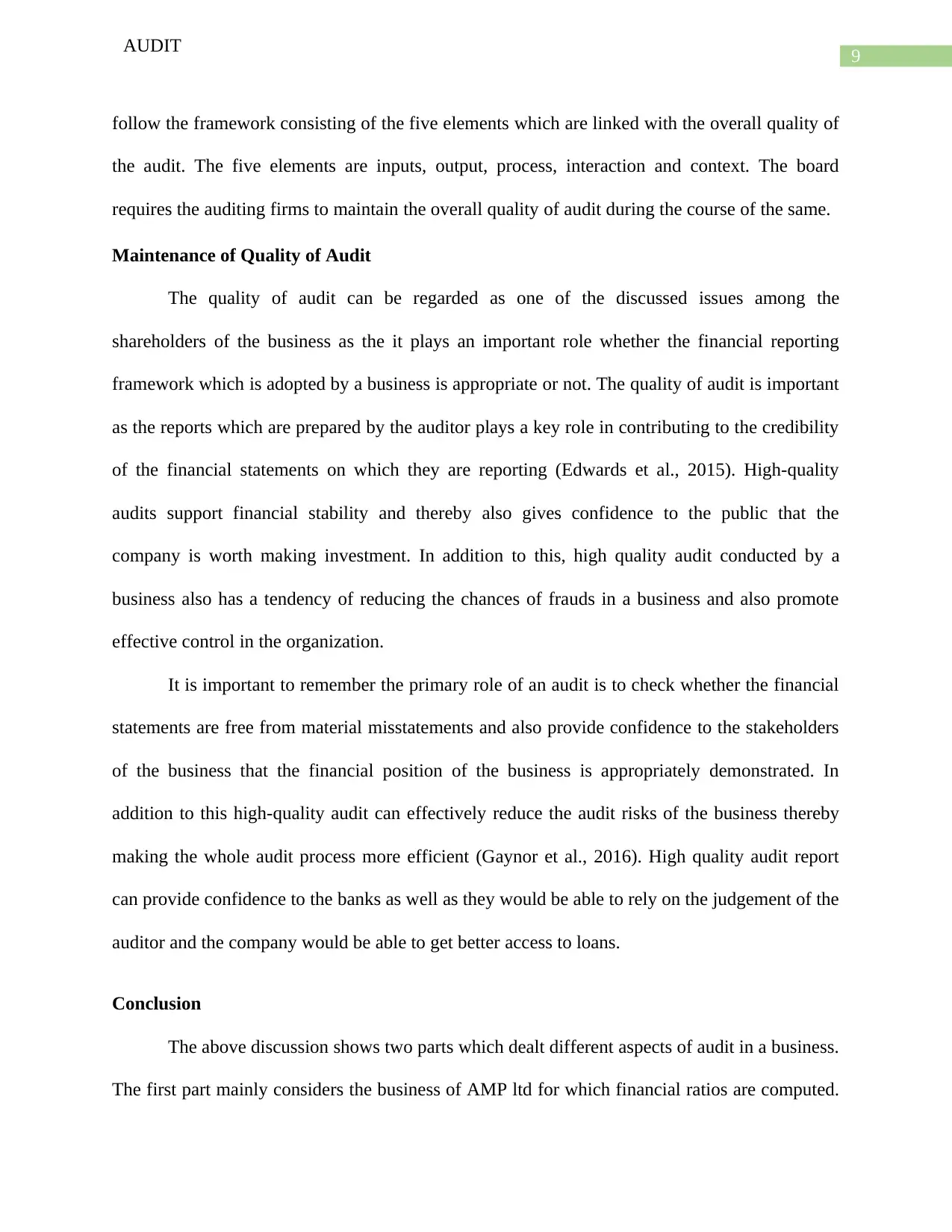
9
AUDIT
follow the framework consisting of the five elements which are linked with the overall quality of
the audit. The five elements are inputs, output, process, interaction and context. The board
requires the auditing firms to maintain the overall quality of audit during the course of the same.
Maintenance of Quality of Audit
The quality of audit can be regarded as one of the discussed issues among the
shareholders of the business as the it plays an important role whether the financial reporting
framework which is adopted by a business is appropriate or not. The quality of audit is important
as the reports which are prepared by the auditor plays a key role in contributing to the credibility
of the financial statements on which they are reporting (Edwards et al., 2015). High-quality
audits support financial stability and thereby also gives confidence to the public that the
company is worth making investment. In addition to this, high quality audit conducted by a
business also has a tendency of reducing the chances of frauds in a business and also promote
effective control in the organization.
It is important to remember the primary role of an audit is to check whether the financial
statements are free from material misstatements and also provide confidence to the stakeholders
of the business that the financial position of the business is appropriately demonstrated. In
addition to this high-quality audit can effectively reduce the audit risks of the business thereby
making the whole audit process more efficient (Gaynor et al., 2016). High quality audit report
can provide confidence to the banks as well as they would be able to rely on the judgement of the
auditor and the company would be able to get better access to loans.
Conclusion
The above discussion shows two parts which dealt different aspects of audit in a business.
The first part mainly considers the business of AMP ltd for which financial ratios are computed.
AUDIT
follow the framework consisting of the five elements which are linked with the overall quality of
the audit. The five elements are inputs, output, process, interaction and context. The board
requires the auditing firms to maintain the overall quality of audit during the course of the same.
Maintenance of Quality of Audit
The quality of audit can be regarded as one of the discussed issues among the
shareholders of the business as the it plays an important role whether the financial reporting
framework which is adopted by a business is appropriate or not. The quality of audit is important
as the reports which are prepared by the auditor plays a key role in contributing to the credibility
of the financial statements on which they are reporting (Edwards et al., 2015). High-quality
audits support financial stability and thereby also gives confidence to the public that the
company is worth making investment. In addition to this, high quality audit conducted by a
business also has a tendency of reducing the chances of frauds in a business and also promote
effective control in the organization.
It is important to remember the primary role of an audit is to check whether the financial
statements are free from material misstatements and also provide confidence to the stakeholders
of the business that the financial position of the business is appropriately demonstrated. In
addition to this high-quality audit can effectively reduce the audit risks of the business thereby
making the whole audit process more efficient (Gaynor et al., 2016). High quality audit report
can provide confidence to the banks as well as they would be able to rely on the judgement of the
auditor and the company would be able to get better access to loans.
Conclusion
The above discussion shows two parts which dealt different aspects of audit in a business.
The first part mainly considers the business of AMP ltd for which financial ratios are computed.
Paraphrase This Document
Need a fresh take? Get an instant paraphrase of this document with our AI Paraphraser

10
AUDIT
On the basis of such financial ratios various risks of the business are identified. The above
discussion mentions the audit procedures which is to be applied by the auditor to ensure that the
risks associated with the audit can be minimized. The second part deals with the quality of audit
and how the same can be beneficial for the users as well as the companies.
AUDIT
On the basis of such financial ratios various risks of the business are identified. The above
discussion mentions the audit procedures which is to be applied by the auditor to ensure that the
risks associated with the audit can be minimized. The second part deals with the quality of audit
and how the same can be beneficial for the users as well as the companies.
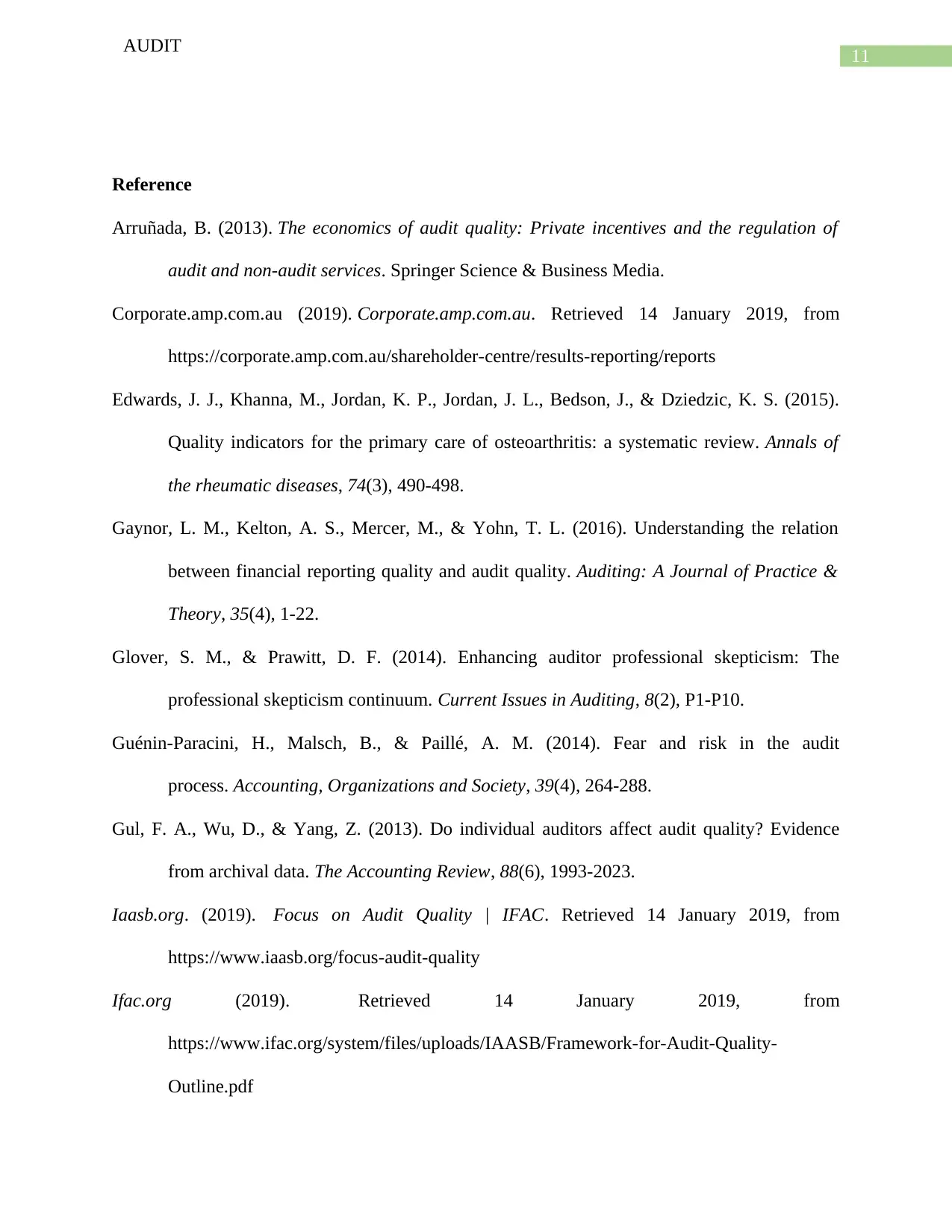
11
AUDIT
Reference
Arruñada, B. (2013). The economics of audit quality: Private incentives and the regulation of
audit and non-audit services. Springer Science & Business Media.
Corporate.amp.com.au (2019). Corporate.amp.com.au. Retrieved 14 January 2019, from
https://corporate.amp.com.au/shareholder-centre/results-reporting/reports
Edwards, J. J., Khanna, M., Jordan, K. P., Jordan, J. L., Bedson, J., & Dziedzic, K. S. (2015).
Quality indicators for the primary care of osteoarthritis: a systematic review. Annals of
the rheumatic diseases, 74(3), 490-498.
Gaynor, L. M., Kelton, A. S., Mercer, M., & Yohn, T. L. (2016). Understanding the relation
between financial reporting quality and audit quality. Auditing: A Journal of Practice &
Theory, 35(4), 1-22.
Glover, S. M., & Prawitt, D. F. (2014). Enhancing auditor professional skepticism: The
professional skepticism continuum. Current Issues in Auditing, 8(2), P1-P10.
Guénin-Paracini, H., Malsch, B., & Paillé, A. M. (2014). Fear and risk in the audit
process. Accounting, Organizations and Society, 39(4), 264-288.
Gul, F. A., Wu, D., & Yang, Z. (2013). Do individual auditors affect audit quality? Evidence
from archival data. The Accounting Review, 88(6), 1993-2023.
Iaasb.org. (2019). Focus on Audit Quality | IFAC. Retrieved 14 January 2019, from
https://www.iaasb.org/focus-audit-quality
Ifac.org (2019). Retrieved 14 January 2019, from
https://www.ifac.org/system/files/uploads/IAASB/Framework-for-Audit-Quality-
Outline.pdf
AUDIT
Reference
Arruñada, B. (2013). The economics of audit quality: Private incentives and the regulation of
audit and non-audit services. Springer Science & Business Media.
Corporate.amp.com.au (2019). Corporate.amp.com.au. Retrieved 14 January 2019, from
https://corporate.amp.com.au/shareholder-centre/results-reporting/reports
Edwards, J. J., Khanna, M., Jordan, K. P., Jordan, J. L., Bedson, J., & Dziedzic, K. S. (2015).
Quality indicators for the primary care of osteoarthritis: a systematic review. Annals of
the rheumatic diseases, 74(3), 490-498.
Gaynor, L. M., Kelton, A. S., Mercer, M., & Yohn, T. L. (2016). Understanding the relation
between financial reporting quality and audit quality. Auditing: A Journal of Practice &
Theory, 35(4), 1-22.
Glover, S. M., & Prawitt, D. F. (2014). Enhancing auditor professional skepticism: The
professional skepticism continuum. Current Issues in Auditing, 8(2), P1-P10.
Guénin-Paracini, H., Malsch, B., & Paillé, A. M. (2014). Fear and risk in the audit
process. Accounting, Organizations and Society, 39(4), 264-288.
Gul, F. A., Wu, D., & Yang, Z. (2013). Do individual auditors affect audit quality? Evidence
from archival data. The Accounting Review, 88(6), 1993-2023.
Iaasb.org. (2019). Focus on Audit Quality | IFAC. Retrieved 14 January 2019, from
https://www.iaasb.org/focus-audit-quality
Ifac.org (2019). Retrieved 14 January 2019, from
https://www.ifac.org/system/files/uploads/IAASB/Framework-for-Audit-Quality-
Outline.pdf
⊘ This is a preview!⊘
Do you want full access?
Subscribe today to unlock all pages.

Trusted by 1+ million students worldwide
1 out of 14
Related Documents
Your All-in-One AI-Powered Toolkit for Academic Success.
+13062052269
info@desklib.com
Available 24*7 on WhatsApp / Email
![[object Object]](/_next/static/media/star-bottom.7253800d.svg)
Unlock your academic potential
Copyright © 2020–2025 A2Z Services. All Rights Reserved. Developed and managed by ZUCOL.





